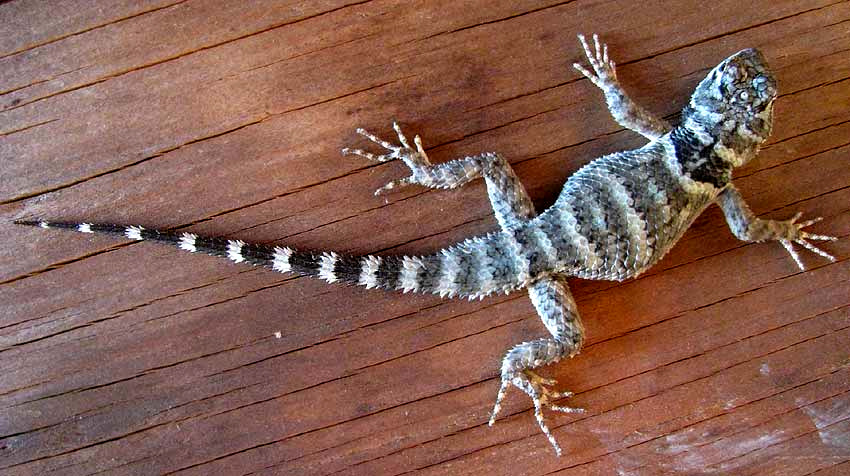Excerpts from Jim Conrad's
Naturalist Newsletter

from the September 1, 2013 Newsletter issued from the Frio Canyon Nature Education Center in the valley of the Dry Frio River in northern Uvalde County, southwestern Texas, on the southern border of the Edwards Plateau; elevation ~1750m (~5750 ft); N29.62°, W99.86°; USA
CREVICE SPINY LIZARD
I can't get over how many kinds of "spiny lizard," genus Sceloporus, there are. This week one morning when I opened the hunter's blind in which the bicycle is stored, by golly yet another one we haven't seen was hanging on the plywood wall, as you can see above.
Black collars grace several spiny lizard species, but in our area only one black-collared species also bears such large, protruding scales and is so vividly banded along the body's entire length.
Therefore, this one was easy to identify as the Crevice Spiny Lizard, SCELOPORUS POINSETTI, our tenth Sceloporus species. We may still encounter more, for about 90 Sceloporus species are recognized at the moment, though there's much debate as to whether the genus consists of a few very variable species, or much more than 90. You might enjoy comparing this one with our previous nine spiny lizard species linked to on our Lizard Index Page at http://www.backyardnature.net/n/lizards.htm.
Crevice Spiny Lizards are described as living on limestone and other exposed rocky outcrops in arid northeastern Mexico, southern New Mexico and southwestern Texas. They're said to be elusive, quick to hide among stones and crevices, so encountering this one occupying a hunter's blind and willing to let me take such a close picture may be a bit anomalous. However, he did streak off the moment the above picture was taken, precluding a shot from the side.
This species reaches nearly a foot long, but ours was only about half that, apparently a young one. My neighbor Phred says that the ones he sees are big ones.
Crevice Spiny Lizards are insectivorous, eating a wide variety of spiders, beetles, and other arthropods, plus they've been seen consuming tender vegetation. They're one of several spiny lizard species that are "ovoviviparous" -- meaning that their babies develop in eggs remaining inside their mother's body until they hatch. It looks like the mother is giving birth to fully formed babies but in fact the eggs are just hatching inside her, with no placental connection between the unborn young and the mother.